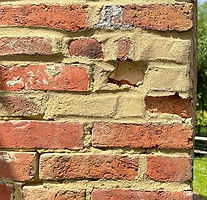
MASONRY
There are several reasons why the brick, stone, or flint features of your home may require attention. External walls are constantly exposed to the elements—weather, plant growth, chemicals, and pollution—and their longevity depends on both the quality of the original construction and the care they've received over time. We specialise in repairing and maintaining your home’s beautiful brick and stonework, ensuring its continued strength and aesthetic appeal.
There are excellent publicly available resources on masonry and its use in traditional buildings, as well as a range of other topics related to the conservation of historic buildings in the UK. If you're interested in learning more, please have a look at our Blog.
Rebuilding brickwork
Brickwork that shows signs of excessive lean or distortion may require careful deconstruction and rebuilding. We aim to preserve as much of the original brick as possible, reusing it in the reconstruction. For chimneys, we ensure the rebuild mirrors the original design and dimensions, replacing any damaged bricks with carefully matched ones in terms of colour, texture, size, and strength. A lime mortar, specifically chosen for its colour, texture, and strength, is used to re-lay the bricks and for any necessary flaunching.
The deconstruction process is carried out brick by brick using a combination of hand tools and machinery to maximise the number of bricks that can be salvaged for reuse. Each brick is meticulously cleaned with water and hand tools to remove mortar before being set aside for the rebuild. If needed, chimney pots can be replaced with matching replacements.
Additionally, any lime flaunching or lead flashing at the roofline can be replaced as necessary.
See also Lime Pointing and our Blog.


Replacing brickwork


We replace damaged, missing, or deteriorated bricks with carefully selected replacements that closely match the original in size, colour, texture, and strength. Suitable bricks are often sourced from reclamation yards or traditional brickworks to ensure an authentic match.
To begin, the surrounding mortar is meticulously removed using hand tools or a specialist masonry saw. Once the damaged brick is removed, the cavity is thoroughly cleaned of any loose mortar or debris and dampened with water to prepare for the new brick.
We then apply lime mortar, custom-matched to the surrounding material, to fill the space, and insert the replacement brick. The joints around the brick are packed securely and shaped to blend seamlessly with the existing brickwork.
Cracks and breaks in bricks can occur for a variety of reasons, some of which may indicate underlying issues. We can guide you through the causes and advise on whether additional work is needed to stabilise your brickwork.
See also Lime Pointing and our Blog.
Repairing brickwork
Cracks in masonry can be repaired in various ways, depending on their size and severity. Smaller cracks can often be addressed by raking out the affected area, repointing, and replacing any damaged bricks or stone. For cracks larger than 5mm, we use a technique called masonry stitching, where stainless steel reinforcement bars are embedded at specific intervals and depths within the brickwork, secured with a specialist grout or resin. The joint is then finished with lime mortar to seamlessly match the surrounding wall.
Cracks in masonry can indicate an ongoing underlying issue, or they may be the result of long-past settling that no longer poses a concern. We can assess the situation to determine the cause. If the cracks are linked to an active problem, it's essential to address the root cause before proceeding with repairs.
See also Lime Pointing.

Flint walls

Flint walls are a traditional form of masonry found primarily in regions where flint is abundant, such as West Sussex. Known for their distinctive appearance, these walls often feature a mix of irregularly shaped flint stones embedded in mortar.
We specialise in repairing a variety of flint walls, each with unique characteristics based on the way the flint is cut, arranged, and combined with other materials. These include:
-
Knapped: Where flint is carefully chipped or split to expose the smooth inner surface, creating a flat face on one side.
-
Rough: Using flint in its natural, uncut form for a more rustic appearance.
-
Coursed and Random: Differing in the arrangement of the flint stones—coursed walls feature regular patterns, while random walls have a more irregular, natural layout.
-
Combination: A mix of flint, brick, or stone for added texture and visual interest.
-
Galleted: Characterised by small, thin pieces of flint inserted into the mortar joints (as seen in the image opposite).
-
Flushwork: A decorative method where snapped flint is laid flush with one another, with minimal joint gaps for a smooth, uniform appearance.
Whether your flint wall is a classic, time-worn feature or a more decorative installation, we can provide expert repairs that respect its original craftsmanship.
See also our Blog.

